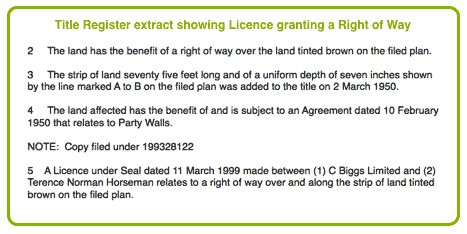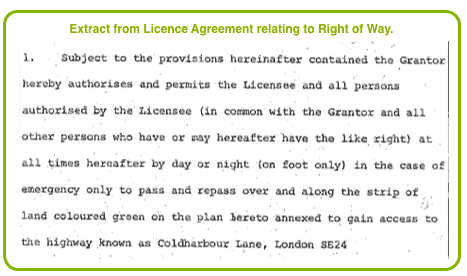Introduction
All of the examples in this chapter are based on actual occurrences. Those included do not represent an exhaustive list, and many more examples could have been included. Each property and each right of way is unique. The examples provided represent a broad view of those more commonly found.
ROW over a Public Footpath
In this sample the A section of the Title Register contains a clause that refers to a private road or footpath at the rear of the property and authorises the use of it. It is further identified by being coloured brown on the Title Plan.
ROW over Rear Passageway
In this sample the dominant tenement has a right of way over a passageway to the rear.

ROW Claimed by Owner
In this sample the land owner has claimed, unchallenged, that he has the benefit of a right of way over a track to the west of the property, and this claim has been registered on the title.

ROWs in Adjacent Properties
The difference in the Titles Plans showing the rights of way for the dominant and servient tenements is evidenced in these samples created for the purpose from actual Title Plans of two adjoining properties.


The right of way exists along the northern border of the first property, and the southern border of the second property. The latter shows more detail of the right of way, together with the Title Number of another property affected by it. The rights of way are indicated by letters along the border, where the right of way exists. Note how the red edging of the properties occurs inside the black OS borders.
The Title Registers for these properties, between them, complete the description and location of this right of way. It is evident from an examination of the Plans and Registers that a far better picture of the right of way can be gleaned from reading both Registers and Plans together. It is for this reason that we provide title documents for both properties with our search.
ROWs in Licence Agreement



In this sample Title Plans for the dominant and servient tenements (the two adjacent properties) are shown for contrast. The Title Register describes the servient tenement as having a right of way over the area tinted brown on the plan, and states that an additional strip of land has been added to the title for the servient tenement. There then follows a statement that a licence was granted to formally grant the right of way. The land coloured blue on the first plan is part of the servient tenement (the retained land) and is the same as that coloured brown on the second plan, and which is subject to a right of way. The land edged red is land sold to the dominant tenement and which now has its own Title.

A copy of the relevant clause of the licence is shown. The reference to land coloured green refers to the Deed Plan, and is the same land as that coloured brown on the Title Plan.
ROWs in Deed Schedules
In this sample the Right of Way appears in detail in a Schedule contained in a Conveyance Deed and is illustrated on a plan attached to the deed.

ROW following Sale of Part
This sample shows a right of way granted following the sale of part of the land that necessitated the grant of a right of way. It is shown as a blue tint on the sold off land (edged in green) and continues as a brown tint on the retained land. It is further detailed in a Plan attached to a Conveyance (a Deed Plan (not shown here)).

Rectification of Title Documents
Title Registers will be amended, or rectified, where an error has been made or uncertainty has been created, in the description of a right of way. In the sample above it was necessary to change the description of the property and to create certainty as to the position of the right of way.

More Detail in Title Plan
The detail in the Title Plan will often not contain the same amount of detail as in a Deed Plan attached to the Deed creating the Right of Way.
In this sample the C Section of the Title Register quotes an extract from a Conveyance creating the Right of Way. It allows owners and occupiers of the land edged in blue on the Deed Plan a right of way over part of the land edged in red as indicated by black hatching. None of this detail is shown on the Title Plan.



Where to Find ROWs in the Register
In the following sample of the A section of the Title Register for the dominant tenement the Right of Way is clearly shown as benefitting the property, providing a right of way for the owners over the adjoining land.

In the sample of the C section of the Title Register for the servient tenement (the adjoining property) the Right of Way is clearly shown as a charge or burden on the land, i.e. the owners are obliged to allow the adjoining land owners a right of way over their land.
